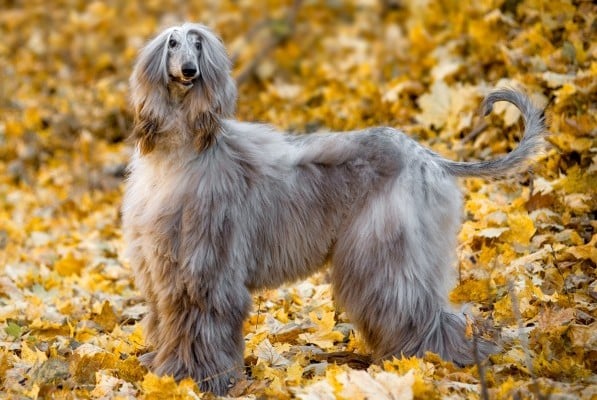Click Below to Skip Ahead
The Afghan Hound, which originates from Afghanistan, is easily recognized for its flowing locks and piercing eyes. It was bred as a hunting dog in the mountains and deserts of Afghanistan. They were bred to have bags of stamina and to be courageous even when facing down large animals like Leopards. It is an independent dog that can be aloof with strangers but is loyal and loving with family.
Breed Overview
Height:
24–28 inches
Weight:
40–60 pounds
Lifespan:
12–14 years
Colors:
Black, red, cream
Suitable for:
Families that have time to play and are looking for a loving dog
Temperament:
Loyal, loving, playful, joyful, aloof
The most notable characteristic of the Afghan Hound is its long hair. These dogs offer more than just looks, though. They are energetic and lively, typically performing very well in coursing events. Owners looking to take on the breed not only need to be able to provide enough exercise and activity to keep them healthy, but they should be prepared for the independent nature of the breed. With that said, the breed is loyal and loving with its family and owners claim the breed to be fun and somewhat clownish, although this behavior tends to subside as the dog matures.
Afghan Hound Dog Breed Characteristics
Afghan Hound Puppies
Although adult Afghan Hounds have long, flowing hair, young puppies are quite different. They have short coats with long facial hair. They require much less maintenance and grooming than their adult counterparts. Owners should make the most of this as the breed requires daily grooming when it reaches adolescence and throughout adulthood.
This is an expensive breed, and although most people can easily recognize the Afghan Hound, it isn’t commonly found. Prospective owners will need to do their research to find reputable and reliable breeders. Always do your due diligence when choosing a breeder. Look for reviews from other owners that have dealt with the breeder. Ring and ask any questions you have about the breed and the specific puppies you are interested in. Arrange to visit and meet the puppies, as well as the mom, and inspect the young dogs to ensure that they are fit and healthy.
Because this breed can be independent, owners need to start training their puppies as soon as possible. This will help teach the basics and it will set them up for successful training in the future. The breed can also be quite aloof with strangers, so early socialization, which is important with all breeds, is especially important with the Afghan Hound. Sign up for puppy classes. Not only does this help give a basic understanding of training techniques and methods, but it will allow your puppy to interact with other dogs and people in a safe and sympathetic environment.
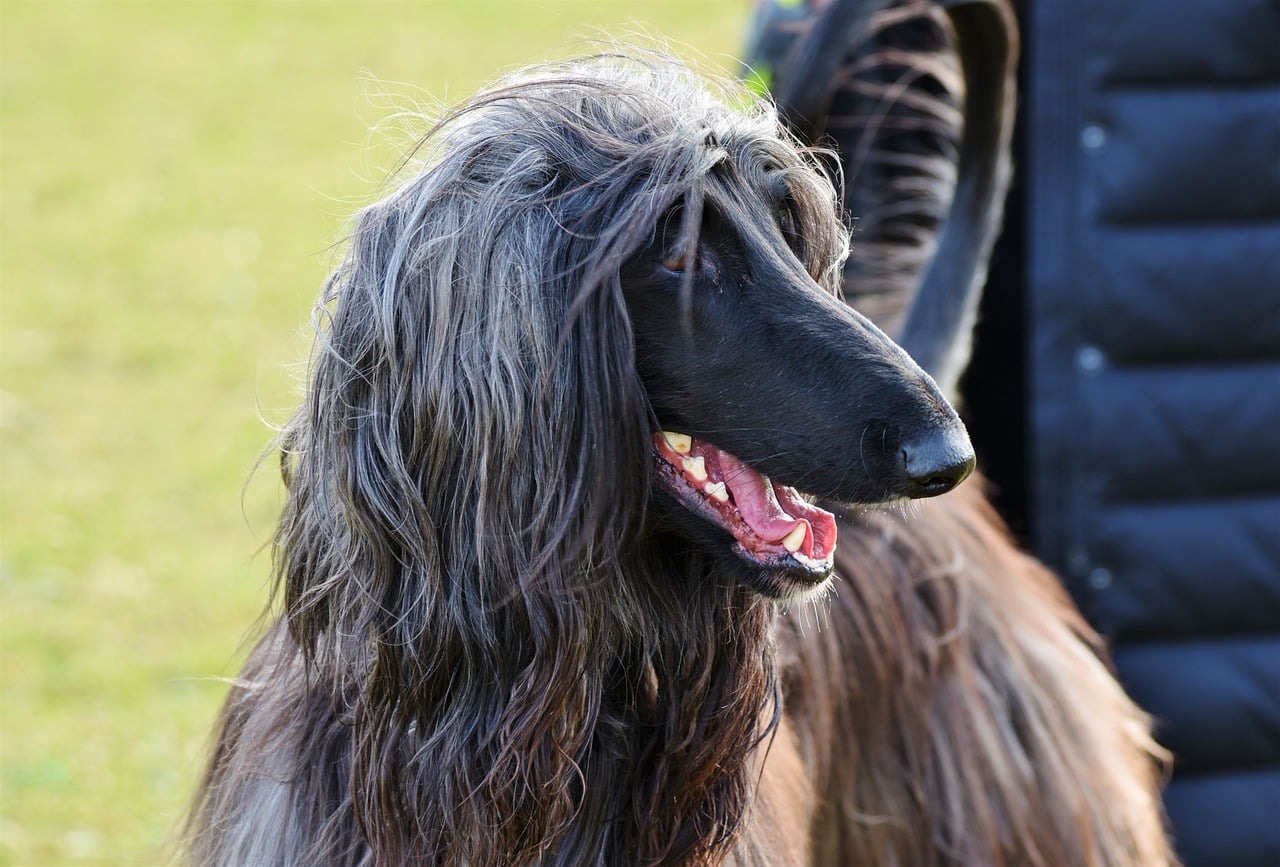
Temperament & Intelligence of the Afghan Hound
The Afghan Hound was bred to hunt large animals. It kept leopards and other big predators at bay until the hunter arrived to fend the animal off. As such, the Afghan is brave. It would also have been left to patrol large areas of desert and mountains so it has stamina, strength, and agility. The athleticism of the breed can come as a surprise, especially to those who only see the long hair and striking eyes.
Although it is an independent dog and can be aloof with strangers, the Afghan will form close bonds with its family and others that it gets to know. It is a loyal and loving pup that will quickly become an integral part of the family. It is a playful and comical dog, especially when younger, and will form especially close bonds with those that can match these characteristics. It tends to get along with other animals, especially other dogs, and is good with children, which makes the Afghan a good dog for any family.
Are These Dogs Good for Families? 👪
The breed is known to be loyal and loving with family members. It will get along with its adult family and will form a close bond with those that play or lavish attention on it. It is also known to be good with children, always up for a game and some playtime.
Despite its somewhat regal appearance, the Afghan is a hardy and sturdy dog, but children should be taught to be respectful of the breed. That long mane is very tempting for children who are looking to get hold of something and pull themselves up.
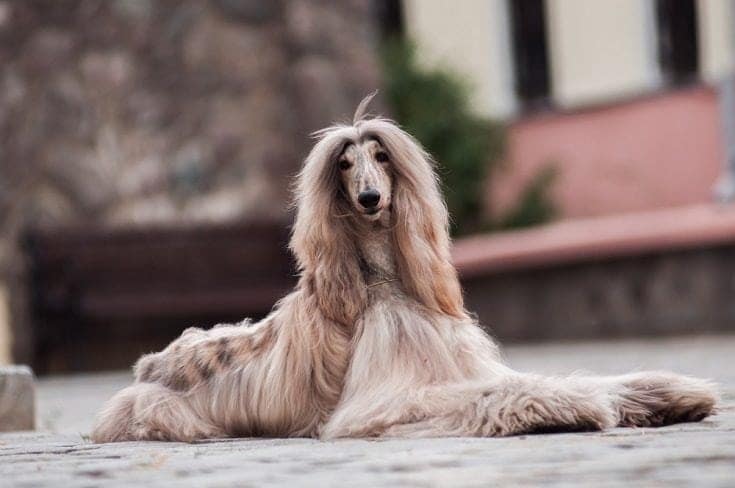
Does This Breed Get Along With Other Pets?
Bred as a hunting dog, the Afghan Hound does retain a prey drive, which means that they can chase cats and smaller animals. If there are small animals in the area, you should avoid letting the Afghan off leash unless you have perfect recall.
However, with careful introductions, the breed will get along with other animals in the house. They typically get on well with other Affies in the same family. They can make good playmates because both will want to play and they will encourage the other to take part in games and fun times.
However, even after introductions, they might be indifferent to other pets in the house. In the home, you should never let your Afghan Hound spend time unattended with small animals.
Things to Know When Owning an Afghan Hound
The Afghan Hound’s temperament makes it a good choice for families with children, as well as individuals and couples. It can get along with other pets, too, but while this makes it a good choice for a lot of families, no breed is ideal for all owners. Below are other factors to consider when thinking about introducing one of this unique breed into your family.
Food & Diet Requirements 🦴
These large dogs have a lot of energy and they need plenty of exercise. Which, in turn, means they also have hearty appetites. Expect to feed between 2 and 2 1/2 cups of dry food per day. Adult dogs do best when given two equally sized meals around 12 hours apart. The exact amount you feed will be determined by the actual weight of your dog and according to whether they need to lose or gain weight, as well as any special health or dietary requirements they might have. If yours is an active or working dog that gets more exercise than the typical dog, you will need to feed more.
Always follow your veterinarian’s guidance when it comes to feeding amounts and the type of food you give. If you choose to feed wet food, follow the manufacturer’s guidelines on how much to feed.
Treats can make good training aids, and it is always nice to give your canine friend a special treat for being well-behaved. However, the calories in treats should not make up more than 10% of your dog’s total diet, and whatever calories are given as treats should be deducted from your dog’s total daily allowance. Fresh drinking water should be available at all times and access to the water should not be restricted.
Exercise 🐕
This hunting breed has bags of energy and a lot of stamina, which means it will need a lot of exercise. While daily walks are important, walks alone are unlikely to be enough to tire an Afghan Hound. Look for other, more intensive forms of exercise.
The Afghan Hound excels at events like coursing. Traditionally, coursing events would see dogs like Afghans, as well as Greyhounds and other sighthounds, chasing hares. A more humane alternative uses plastic bags or other items designed to look like hares. These are pulled around a track and the dogs are encouraged to chase the items.
Afghans can also do well in agility and other canine sports, although you are as likely to see them parading in an exhibition ring as you are chasing a tennis ball down a flyball course.
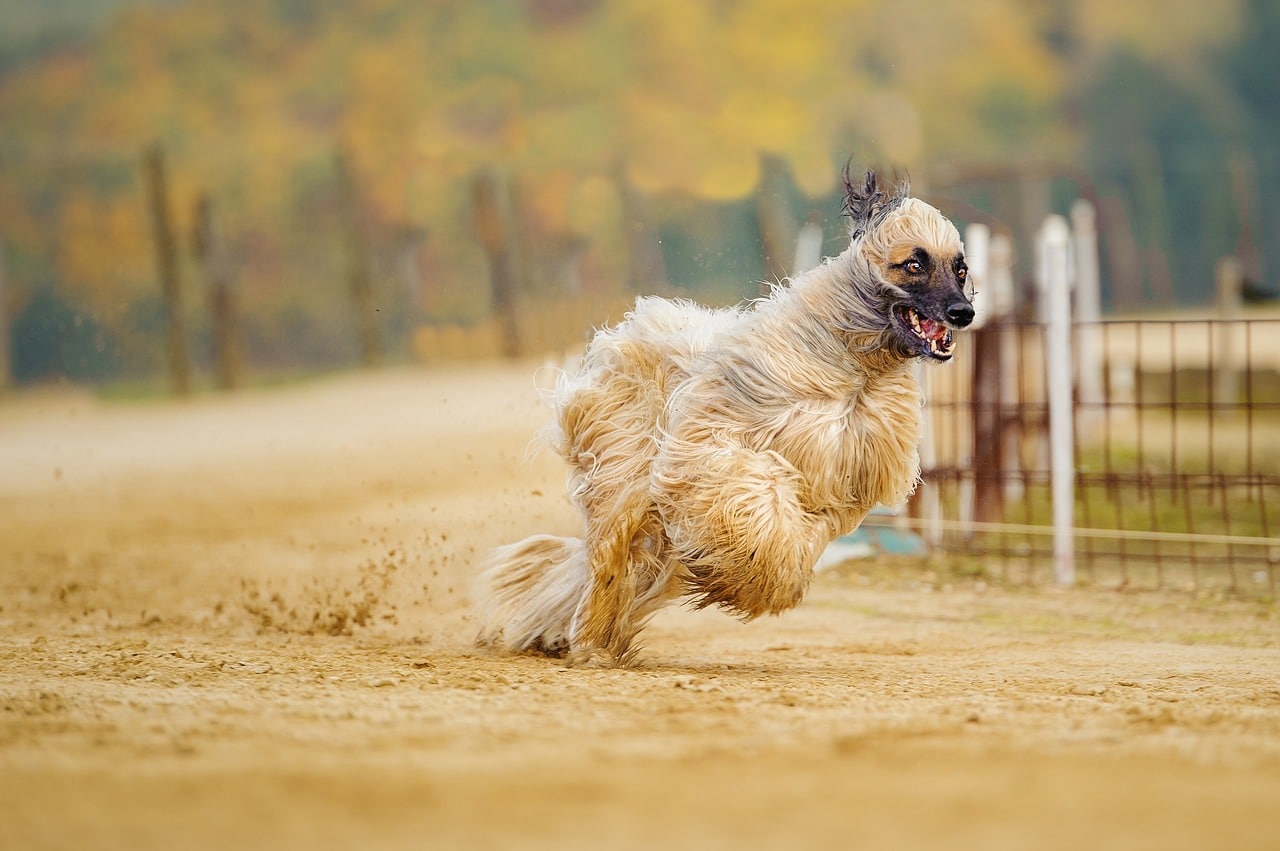
Training 🎾
The independent Afghan Hound can be a little challenging to train because the breed is used to working alone while guarding and protecting. This means that the breed might not be ideal for first-time owners who do not have experience in dog training.
Training requires consistent training, fun training methods, and clear commands. Start training as soon as possible. Although it is still possible to train an adult Afghan Hound, it is easier if the dog has experience of being trained when younger.
Socialization is important. The breed is not known for being aggressive but Afghan Hounds can be aloof with strangers. Early socialization teaches the dog that it doesn’t need to be wary of people or other animals and it will make introductions and walks easier later in life. Like training, socialization should start when the dog is young.
Grooming ✂️
Although they do not require much maintenance when young, adult Afghan Hounds are a different story. That long hair requires a lot of maintenance, and while the dog itself will spend a lot of time grooming, it will also need daily brushing to prevent knots and to ensure it is comfortable and healthy. It will also need regular washing and it is recommended that owners wash their Afghan Hound ideally weekly, but fortnightly at the very least. This will be especially important if your Afghan runs in the mud or swims in water regularly.
The hair will need trimming too, and while it is possible to do this yourself, it can be beneficial to have your Afghan visit a professional groomer every couple of months. Nails need to be trimmed roughly every 2 months or when you can hear them clicking on hard floors. Brush teeth daily or at least three times a week to help avoid dental disease. Check inside your dog’s ears every week, cleaning out any mess using damp cotton wool.
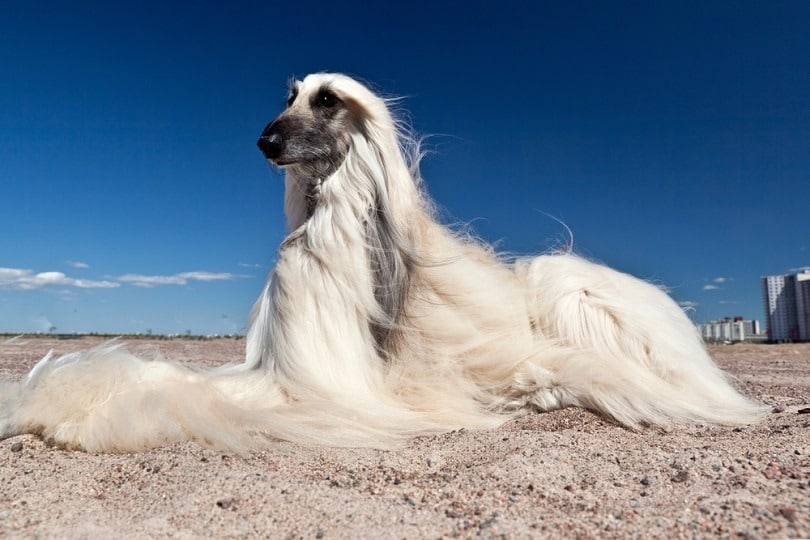
Health and Conditions 🏥
The breed is known to be generally healthy and quite hardy but can be prone to hip dysplasia as well as eye and ear conditions including cataracts.
- Glaucoma
- Progressive Retinal Atrophy
- Retinal Dysplasia
- Cataracts
- Corneal Opacities
- Hip Dysplasia
- Mange
- Thyroid Conditions
Male vs Female
Male Afghan Hounds will grow slightly taller and heavier than females and both sexes are independent but loving. They’re also both liable to the same health conditions. Although it does depend on individual character, the male is more likely to be bold and has greater potential to be aggressive. However, the breed is not known for being overly aggressive.
3 Little-Known Facts About the Afghan Hound
1. They Were Bred for Hunting
Although it is difficult to picture when you see an Afghan Hound in the show ring, behind that majestic hair lies the pounding heart of a hunter. The breed was first raised to hunt large animals like leopards, although it would have held the big game off while waiting for hunters to come and take over. Although they are more commonly kept as pets or as exhibition show dogs today, they still possess many of the traits of a hunter.
2. Afghan Hounds Are Incredible Athletes
That hunting pedigree shows itself in several ways. The dog is independent, which can make it difficult to train but also means it can be left to its own devices. It is also very athletic with excellent stamina and can run at speeds of up to 40 miles per hour, which puts it on par with the Greyhound, known as the fastest dog on the planet.
3. The First Ever Cloned Dog Was an Afghan Hound
In 2005, a team of Korean scientists cloned a dog named Snuppy. What was unusual about Snuppy was the fact that he was the first ever dog to be cloned, and he was an Afghan Hound. Snuppy was said to be like other Afghan Hounds. He was keen on lamb treats and was prone to excitable jumping. Despite their popularity as pets, dogs came after a long line of other mammals to be cloned. The first mammal to be cloned was Dolly the sheep in 1996. And between Dolly and Scuppy, mice, rabbits, pigs, cows, and even horses were cloned. Snuppy was named Invention of the Year by Time magazine and went on to have puppies of his own in 2008, all of which were born naturally without the need for cloning.
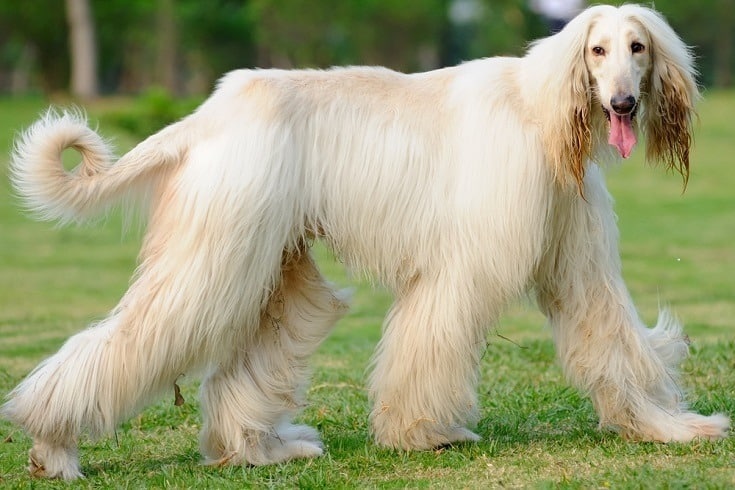
Conclusion
Afghan Hounds have a regal, elegant appearance, thanks to their long coats and beautiful eyes. But beneath those beautiful looks lies the beating heart of a hunting dog. Potential owners need to be prepared for an independent dog that has a high prey drive and needs a lot of exercise. That long hair also means that dogs of this breed require a lot of regular maintenance, including daily brushes and weekly washes.
But owners should also be prepared for a pet pup that will show love and loyalty to its family members. The Afghan Hound is considered a good pet for families with children and it can also be introduced to other dogs, typically getting along best with other Afghan Hounds. This healthy, hardy breed can make an excellent choice of pet for the right owner.
Related Reads:
Featured Image Credit: courtesy, Shutterstock

